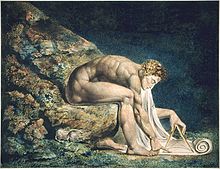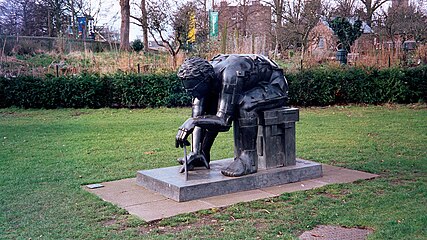Newton (Paolozzi)


Newton, sometimes known as Newton after Blake, is a 1995 work by the sculptor Eduardo Paolozzi. The large bronze sculpture is displayed on a high plinth in the piazza outside the British Library in London.
The sculpture is based on
Paolozzi had admired Blake since viewing a large print of Newton at the
The sculpture includes Paolozzi's self-portrait as the naked Newton, measuring the universe with his dividers. The eyes were copied from
The final full-size sculpture stands 12 feet (3.7 m) high, and is mounted on a high plinth. The bronze was cast by the Morris Singer foundry, and funded by the Foundation for Sport and the Arts. It was included in the Grade I listing of the library, granted in 2015.
A maquette was donated by the artist to the
A similar sculpture by Paolozzi from 1989, Master of the Universe, is on display at
Gallery
-
Master of the Universe (1989) at Modern Two, Edinburgh
-
Concept of Newton in Kowloon Park, Hong Kong
References
- ^ Sir Eduardo Paolozzi, Newton, 1988, Tate Gallery
- The British Library, piazza, boundary wall and railings to Ossulston Street, Euston Road and Midland Road, National Heritage List for England, Historic England
- Statue: British Library – Newton, London Remembers
- Paolozzi’s Newton, British Library, Tate Gallery
- Paolozzi's Sculpture of Isaac Newton, Isaac Newton Institute for Mathematical Sciences
- Eduardo Paolozzi, Master of the Universe (1989), National Galleries Scotland
- British Library, Euston Road NW1, Ornamental Passions
- Blake 2.0: William Blake in Twentieth-Century Art, Music and Culture, edited by Steve Clark, T. Connolly, Jason Whittaker
- The Architecture of the British Library at St. Pancras, Roger Stonehouse, Gerhard Stromberg, p. 175


